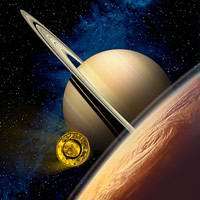Huygens Probe Successfully Detached to Begin Its Final Journey

The ESA's Huygens probe has successfully detached from NASA's Cassini orbiter early this morning to begin a 21-day journey to Saturn's moon Titan. NASA's Deep Space Network tracking stations in Madrid, Spain, and Goldstone, Calif., received the signal at 7:24 p.m. (PST). All systems performed as expected and there were no problems reported with the Cassini spacecraft.
Huygens probe is now on a controlled collision course toward Saturn's largest and most mysterious moon, Titan, where on 14 January it will make a descent through one of the most intriguing atmospheres in the solar system to an unknown surface.
The Cassini orbiter, carrying Huygens on its flank, entered an orbit around Saturn on 1 July 2004, and began to investigate the ringed planet and its moons for a mission that will last at least four years.
The Huygens probe, was bolted to Cassini and has been riding along during the nearly seven-year journey to Saturn largely in a "sleep" mode. Huygens will be the first human-made object to explore on-site the unique environment of Titan, whose chemistry is assumed to be very similar to that of early Earth before life formed. Huygens will tell us whether this assumption is correct.
The separation occurred at 02:00 UTC (03:00 CET): A few minutes after separation, Cassini turned back to Earth and relayed back information about the separation. This signal then took 1 hour and 8 minutes to cross the 1.2 billion kilometres separating the Cassini spacecraft and Earth.
The Huygens probe will remain dormant until the onboard timer wakes it up just before the probe reaches Titan's upper atmosphere on Jan. 14, 2005. Then it will begin a dramatic plunge through Titan's murky atmosphere, tasting its chemical makeup and composition as it descends to touch down on its surface. The data gathered during this 2-1/2 hour descent will be transmitted from the probe to the Cassini orbiter. Afterward, Cassini will point its antenna to Earth and relay the data through NASA's Deep Space Network to JPL and on to the European Space Agency's Space Operations Center in Darmstadt, Germany, which serves as the operations center for the Huygens probe mission. From this control center, ESA engineers will be tracking the probe and scientists will be standing by to process the data from the probe's six instruments.
On Monday, Dec. 27, the Cassini orbiter will perform a deflection maneuver to keep it from following Huygens into Titan's atmosphere. This maneuver will also establish the required geometry between the probe and the orbiter for radio communications during the probe descent.
Huygens is scheduled to enter Titan’s atmosphere at about 09:06 UTC (10:06 CET) on 14 January, entering at a relatively steep angle of 65° and a velocity of about 6 km/s. The target is over the southern hemisphere, on the day side. Protected by an ablative thermal shield, the probe will decelerate to 400 m/s within 3 minutes before it deploys a 2.6 m pilot chute at about 160 km. After 2.5 seconds this chute will pull away the probe’s aft cover and the main parachute, 8.3 m in diameter, will deploy to stabilise the probe. The front shield will then be released and the probe, whose main objective is to study Titan’s atmosphere, will open inlet ports and deploy booms to collect the scientific data. All instruments will have direct access to the atmosphere to conduct detailed in-situ measurements of its structure, dynamics and chemistry. Imagery of the surface along the track will also be acquired. These data will be transmitted directly to the Cassini orbiter, which, at the same time, will be flying over Titan at 60 000 km at closest approach. Earth-based radiotelescopes will also try to detect the signal’s tone directly.
After 15 minutes, at about 120 km, Huygens will release its main parachute and a smaller 3 m drogue chute will take over to allow a deeper plunge through the atmosphere within the lifetime of the probe’s batteries.
The descent will last about 140 minutes before Huygens impacts the surface at about 6 m/s. If the probe survives all this, its extended mission will start, consisting in direct characterisation of Titan’s surface for as long as the batteries can power the instruments and the Cassini orbiter is visible over the horizon at the landing site, i.e. not more than 130 minutes.
At that time, the Cassini orbiter will reorient its main antenna dish toward Earth in order to play back the data collected by Huygens, which will be received by NASA’s 70-m diameter antenna in Canberra, Australia, 67 minutes later. Three playbacks are planned, to ensure that all recorded data are safely transmitted to Earth. Then Cassini will continue its mission exploring Saturn and its moons, which includes multiple additional flybys of Titan in the coming months and years.
Bigger than Mercury and slightly smaller than Mars, Titan is unique in having a thick hazy nitrogen-rich atmosphere containing carbon-based compounds that could yield important clues about how Earth came to be habitable. The chemical makeup of the atmosphere is thought to be very similar to Earth’s before life began, although colder (-180°C) and so lacking liquid water. The in-situ results from Huygens, combined with global observations from repeated flybys of Titan by the Cassini orbiter, are thus expected to help us understand not only one of the most exotic members of our Solar System but also the evolution of the early Earth's atmosphere and the mechanisms that led to the dawn of life on our planet.
Source: ESA, NASA
















